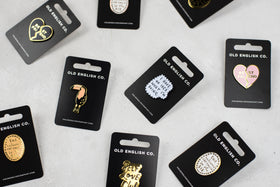A Short Fashion History of Cute Keyrings
How often do you think about your keyring? You might think the answer is 'not very often', but keyrings can make a bigger impact than you believe. Keyrings have long been identified with a sense of place and loyalty, from the keyrings provided by car dealers to the ones sold by resort gift shops. Cute keyrings are for more than just holding keys - they also hold onto memories. There's a reason why keychains are super nostalgic and meaningful - and it runs right through the fashion history of keyrings.

The Early Fashion History of Keyrings
Long before humans needed keyrings to hold onto all their keys, the origins of the keyring were noticeable in other possessions - particularly in charms and talismans. Though not all, most of these charms were worn, either around the neck or wrist.
From the headrest amulets preserved with Ancient Egyptian bodies for protection in the afterlife, to the rabbit's foot, considered lucky in cultures from Africa to Asia, the fashion history of keyrings starts with objects and accessories that had symbolic purposes, as well as style. The interest in charms continued to develop into the industrial era, as they became a practical necessity.
When Were Keychains Invented?
Another important part of the fashion history of keyrings relates to the keychain. The original keychain fastener was used to prevent burglaries, by fastening keys tightly to doors. The invention was patented in 1894 by Frederick J. Loudin. As well as an inventor, Loudin was a member of the Jubilee Singers, a world-famous touring African-American choir who performed for Queen Victoria. Hampered by racism in his country, Loudin never received full credit for his invention, but is today honoured by the Black Inventions Museum.
Since the industrial era, the need for keychains continued to rise with the advent of the motorcar. The earliest cars had to be physically started up by hand, but as time went on, new technological developments improved the motorcar dramatically, leading to requirements for car keys. At this time, car dealerships would provide keychains with the manufacturer's branding to foster a connection with their customers.
When Did People Start Collecting Keyrings?
In the mid-20th century, the fashion history of keyrings boomed. Following the end of the Second World War, travel and tourism was widely encouraged to boost the economy, especially across the US and UK. Gift shops began to open at more locations, offering souvenirs for tourists to return home with, from fridge magnets to cute keyrings. The more keyrings that travellers bought, the more incentive they had to buy more from new places, leading to the development of keyring collections.
Nowadays, keyrings stand for even more than place or practicality. Keyrings have become expressions of identity and style, worn to reflect personality. As well as keeping your keys together, cute keyrings motivate you to 'get stuff done' and remind you that 'you've got this'.
From early good luck charms to cute keyrings, our lives, as well as our keys, have been enriched by keyrings. The fashion history of keyrings shows how cute keyrings have long gone unnoticed for the subtle impact they have on our lives. Whether inspirational or motivational, cute keyrings provide us with on-the-go pick-me-ups that last long after the keys are away in our pockets.



Leave a comment